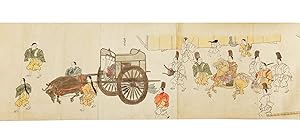About this Item
Scroll on paper (340 x 15,130 mm.), silk brocade outer endpaper at beginning, wooden core roller. [Kyoto]: late Edo copy. The Aoi Matsuri is one of the three most famous annual festivals in Kyoto; it now takes place on 15 of May each year and is held by the important Kamo shrines, the Kamigamo Shrine and Shimogamo Shrine. The festival s origins can be traced to rites performed in the sixth century to appease the gods and to pray for bountiful harvests. It became a more formal annual ritual in the eighth century (Heian era), when Kyoto became the capital and Emperor Kanmu (735-806) recognized the importance of the Kamo shrines to the city s prosperity. The procession starts at the southern gate of the Imperial Palace and makes it way towards the Shimogamo Shrine and finally arrives at the Kamigano Shrine, about eight kilometers away, where shrine rites are performed. The procession participants include the Saiodai (a young woman of the imperial house who has undergone several purification ceremonies), the Imperial Messenger, who leads the procession, Buddhist priests and nuns, dancers, musicians carrying ceremonial instruments, young girls, royal guards in red uniforms carrying bows and arrows, government and civic officials (oftentimes on horseback), and military retainers. The illustrations are large and panoramic, depicting carriages drawn by oxen, attendants of many ranks and professions, each wearing different attire and carrying swords, bows and arrows, musical instruments, etc. There are several breeds of oxen and different types of carriages. One of the carriages is labeled "ingokogi" ["carriage for the retired emperor"]. Street scenes show bystanders, structures decorated with hollyhock vines, and processioners carrying hollyhock sprigs. One highly decorated carriage, with wisteria vines draped from its top, transports an assortment of musical instruments. A musician follows, carrying a koto (vertical harp). A group of dancers, all on horseback, are part of the procession. There is also a scene of three high-ranking court members, all seated, whose first names are Hisayori, Yorizumi, and Hisaaki. The coloring of this scroll appears to be a preliminary version; while it is for the most part well colored, there are neat notes by the artist for the application of further colors. The text, in three sections, provides a history of the festival from earliest times and descriptions of the illustrations that follow in the scroll. Many figures are labeled with their tasks or roles in the procession. At the end of the scroll, we find a note stating that the text and illustrations were copied in "mid-June 1330" by "jushii Takakane Tamenobu kyo" (illustrator) and "Nyudo [several characters indecipherable] Suekuni," who was responsible for the text. Our scroll is a late Edo copy. In excellent and fresh condition, preserved in a handsome lacquer box with a metal handle. Seller Inventory # 9258
Contact seller
Report this item
![]()

